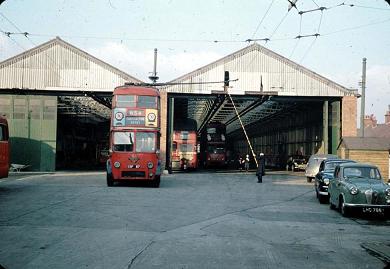Carshalton area
 A brief
transport history A brief
transport history
Suburban London is famously a product of its transport
links. As the railways spread in the 19th and early 20th
centuries, so London spread to accommodate the large and growing
working population in better housing further from the centre.
Planning legislation, in particular the introduction of the green
belt, changed the picture after the second world war, by which time
London and its transport infrastructure were largely formed.
Carshalton and the area to the east
of Sutton is a good example of such suburban development. At
the turn of the century the area was countryside with small towns
and villages, already connected to London by the railway and
growing fast. The introduction of the tram and the opening of Carshalton Beeches station in 1906 provided a
spur to growth, with most of the fields covered with houses by
1939.
Carshalton Depot (CN) was formerly the South Met
tram shed for the Sutton to Croydon route. B1 trolleybus 87
is being attached to the wires on the forecourt in readiness
for a run on the 654. Sadly the silent giants will not
be making an appearance at the running day. Photo ©
Terry Russell
Bus services grew, complementing the railway and tram and
providing local links. The basic structure of services eighty
years ago is recognisable today. The 157 connected Morden Station
with Wallington, having been introduced when the tube reached
Morden in 1926. The tram from Sutton via Carshalton to
Croydon was replaced by trolleybus 654
and then in turn by bus 154.
Single-deck route 87 (renumbered 234/ 234A in 1934) connected Mitcham with
Wallington and Purley, a task now undertaken by the 127.
Of course much has changed too. The 77, formerly a trunk route from Wallington to
London now comes no further south than Tooting. The 88 still serves the Tate Gallery 80 years on, but
doesn't venture further out than Clapham - in 1927 it ran to
Belmont every 12 minutes. All this change reflects two key
changes over the years - employment and travel patterns have
changed dramatically and traffic congestion makes long routes
impractical.
On 15 April 2007, we aim to run the local network broadly as it was 40 years ago on a
Sunday in 1967. Buses of the period will be used
and all services will be free, although use of buses will be at the
discretion of the crews.
|